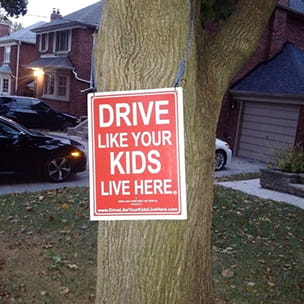A Nudge in Time

I came across an article about “nudging” recently, a concept that was first introduced to us by University of Chicago professors Richard Thaler and Cass Sunstein in Nudge: Improving Decisions about Health, Wealth and Happiness (2008). [1]
The idea behind nudge theory is that a simple adjustment – a nudge – can change our behaviour for the better.
This is the sign hanging from the tree by my house. Our block is trying to nudge drivers to slow down and actually stop at stop signs (it hasn’t had the desired effect though).
One of the advisors in my branch is nudging his clients to work on their estate plan by sending each one a comprehensive estate planning workbook as part of his new client welcome package. He’s having good success. His next challenge will be to get clients to actually implement his recommendations to help them achieve their financial planning goals.
Raymond James likes to nudge its employees into participating in our Annual Giving Campaign by providing dollar matching up to a certain threshold. Last year was a record year for donations by our associates and is one of the reasons we are recognized by Imagine Canada as a caring company.
If constructed properly, a nudge doesn’t restrict available options and therefore is not considered coercive.
I always thought David Chilton constructed an excellent nudge by introducing the notion of “pay yourself first” in his 1989 bestseller, The Wealthy Barber. The barber became wealthy by saving 10% of the top of his paycheque and then investing it. Still good advice 27 years later.
If you would like to learn more about nudges, please visit Professor Thaler’s blog at http://nudges.org/tag/richard-thaler/.
[1] Ly, K., Mazar, N., Zhao, M. and Soman, D. (2014, Winter). A Practitioner’s Guide to Nudging. Rotman Management Magazine, 29-33.




